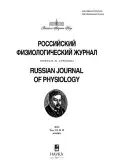Vol 111, No 12 (2025)
FROM THE SPECIAL ISSUE EDITOR
ENDOCRINE REGULATION: PROGRESSIVE TRANSFORMATION OF IDEAS AND APPROACHES
Abstract
 1877-1879
1877-1879


REVIEW
Relationship between Obesity Phenotype and Hormonal Disorders
Abstract
In studies in recent years, changes underlying metabolically unhealthy visceral obesity and leading to the development of cardiometabolic risk factors are defined as a state of uncontrolled secretion of adipokines and cytokines by increased visceral adipose tissue. Meanwhile, deviations in the production of a number of hormones can cause an increase in the amount of fat in the body and contribute to the formation of different phenotypes of obesity with different options for the distribution of adipose tissue. This review summarizes current information on key hormones whose level changes may contribute to obesity and affect body composition. It also summarizes hormonal changes resulting from the development of obesity (ghrelin, leptin, adiponectin, estrogens, androgens and others). A feature of this review is a comparative analysis of sex differences in the role and contribution of hormones to energy metabolism, the pathogenesis of obesity and the formation of different phenotypes. Identifying hormonal profiles that characterize different obesity phenotypes will improve diagnostics, prognosis, and personalized treatment of this pandemic.
 1880-1906
1880-1906


Allosteric Regulators of the Thyroid-Stimulating Hormone Receptor – New Horizons in the Pharmacology of Thyroid Pathology
Abstract
 1907–1932
1907–1932


EXPERIMENTAL ARTICLES
Hormonal Profile of the Offspring of Prenatally Stressed Male Rats with Modeling of Post-traumatic Stress Disorder during Spermatogenesis
Abstract
 1933-1946
1933-1946


Effect of Granulocyte Colony-Stimulating Factor Liposomal Form on the Expression of Genes Associated with Chronic Endometritis
Abstract
 1947-1959
1947-1959


Role of the Oxytocinergic System in Correcting Neurogenic Impairments Induced by Early Life Stress: an in vitro Study
Abstract
 1960–1973
1960–1973


A Comparative Study of Dehydroepiandrosterone-Induced Polycystic Ovary Syndrome Models in Immature and Prepubertal Female Rats
Abstract
 1974-1990
1974-1990












